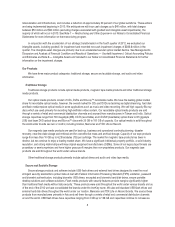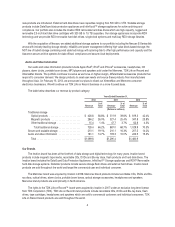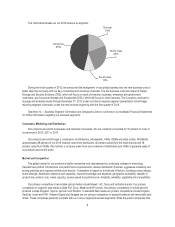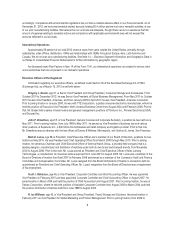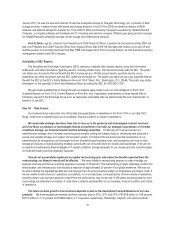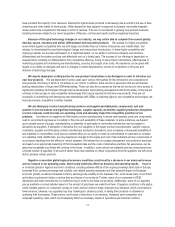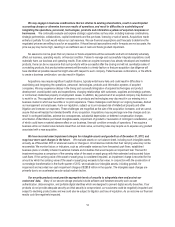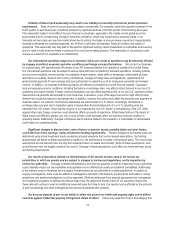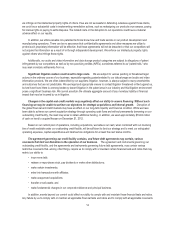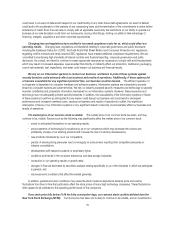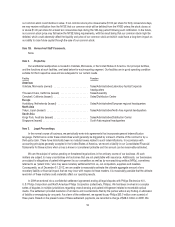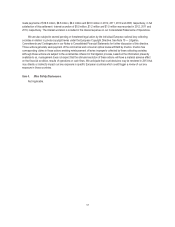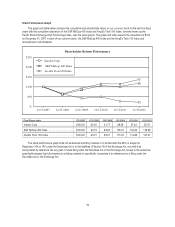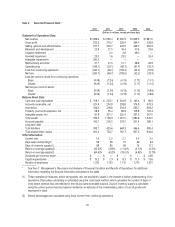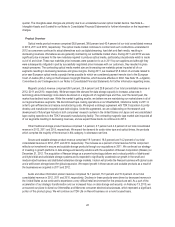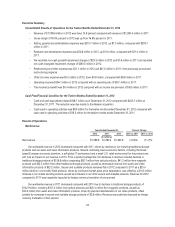Memorex 2012 Annual Report Download - page 16
Download and view the complete annual report
Please find page 16 of the 2012 Memorex annual report below. You can navigate through the pages in the report by either clicking on the pages listed below, or by using the keyword search tool below to find specific information within the annual report.Volatility of demand and seasonality may result in our inability to accurately forecast our product purchase
requirements. Sales of some of our products are subject to seasonality. For example, sales have typically increased in the
fourth quarter of each fiscal year, sometimes followed by significant declines in the first quarter of the following fiscal year.
This seasonality makes it more difficult for us to forecast our business, especially in the volatile current global economic
environment and its corresponding change in consumer confidence, which may impact typical seasonal trends. If our
forecasts are inaccurate, we may lose market share due to product shortages or procure excess inventory or inappropriately
increase or decrease our operating expenses, any of which could harm our business, financial condition and results of
operations. This seasonality also may lead to the need for significant working capital investments in receivables and inventory
and our need to build inventory levels in advance of our most active selling seasons. The seasonality of our products could
change as a result of our acquisitions and divestitures.
Our international operations subject us to economic risk as our results of operations may be adversely affected
by changes in political, economic and other conditions and foreign currency fluctuations. We conduct our business
on a global basis, with approximately 59 percent of our 2012 revenue derived from operations outside of the United States.
Our international operations may be subject to various risks which are not present in domestic operations, including political
and economic instability, terrorist activity, the possibility of expropriation, trade tariffs or embargoes, unfavorable tax laws,
restrictions on royalties, dividend and currency remittances, changes in foreign laws and regulations, requirements for
governmental approvals for new ventures and local participation in operations such as local equity ownership and workers’
councils. In addition, our business and financial results are affected by fluctuations in world financial markets. Changes in
local and regional economic conditions, including fluctuations in exchange rates, may affect product demand in our non-U.S.
operations and export markets. Foreign currency fluctuations can also affect reported profits of our non-U.S. operations where
transactions are generally denominated in local currencies. A recession in any of the regions we serve might affect product
demand and cause fluctuations in exchange rates. In addition, currency fluctuations may affect the prices we pay suppliers for
materials used in our products. Our financial statements are denominated in U.S. dollars. Accordingly, fluctuations in
exchange rates may give rise to translation gains or losses when financial statements of non-U.S. operating units are
translated into U.S. dollars. Given that the majority of our revenues are non-U.S. based, a strengthening of the U.S. dollar
against other major foreign currencies could adversely affect our results of operations. While these factors or the impact of
these factors are difficult to predict, any one or more of them could adversely affect our business, financial condition or
operating results. Additionally, changes in European law or practice related to the imposition or collectability of optical levies
could impact our operating results.
Significant changes in discount rates, rates of return on pension assets, mortality tables and other factors
could affect our future earnings, equity and pension funding requirements. Pension obligations and related costs are
determined using actual investment results as well as actuarial valuations that involve several assumptions. Our funding
requirements are based on these assumptions in addition to the performance of assets in the pension plans. The most critical
assumptions are the discount rate, the long-term expected return on assets and mortality. Some of these assumptions, such
as the discount rate, are largely outside of our control. Changes in these assumptions could affect our future earnings, equity
and funding requirements.
Our results of operations include our determinations of the amount of taxes owed in the various tax
jurisdictions in which we operate and are subject to changes in tax laws and regulations, and to inspection by
various tax authorities. Changes in related interpretations and other tax guidance as well as inspections by tax authorities
could materially impact our tax receivables and payables and our deferred tax assets and deferred tax liabilities. Additionally,
in the ordinary course of business we are subject to examinations by tax authorities in multiple jurisdictions. In addition to
ongoing investigations, there could be additional investigations launched in the future by governmental authorities in various
jurisdictions and existing investigations could be expanded. While we believe we have adopted appropriate risk management
and compliance programs to address and reduce these risks, the global and diverse nature of our operations means that
these risks will continue to exist and additional issues will arise from time to time. Our results may be affected by the outcome
of such proceedings and other contingencies that cannot be predicted with certainty.
Our success depends in part on our ability to obtain and protect our intellectual property rights and to defend
ourselves against intellectual property infringement claims of others. Claims may arise from time to time alleging that
13


